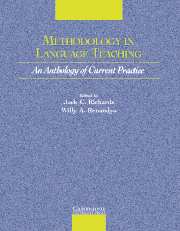Book contents
- Frontmatter
- Contents
- Acknowledgments
- Introduction
- Section I Approaches to Teaching
- Section 2 Lesson Planning and Classroom Management
- Section 3 Classroom Dynamics
- Section 4 Syllabus Design and Instructional Materials
- Section 5 Task and Project Work
- Section 6 Learning Strategies
- Section 7 Teaching Grammar
- Section 8 Teaching Pronunciation
- Section 9 Teaching Speaking
- Section 10 Teaching Listening
- Section 11 Teaching Vocabulary
- Section 12 Teaching Reading
- Section 13 Teaching Writing
- Section 14 Assessment
- Section 15 Technologies in the Classroom
- Section 16 Professional Development
- Credits
- Author Index
- Subject Index
Section 12 - Teaching Reading
Published online by Cambridge University Press: 10 November 2010
- Frontmatter
- Contents
- Acknowledgments
- Introduction
- Section I Approaches to Teaching
- Section 2 Lesson Planning and Classroom Management
- Section 3 Classroom Dynamics
- Section 4 Syllabus Design and Instructional Materials
- Section 5 Task and Project Work
- Section 6 Learning Strategies
- Section 7 Teaching Grammar
- Section 8 Teaching Pronunciation
- Section 9 Teaching Speaking
- Section 10 Teaching Listening
- Section 11 Teaching Vocabulary
- Section 12 Teaching Reading
- Section 13 Teaching Writing
- Section 14 Assessment
- Section 15 Technologies in the Classroom
- Section 16 Professional Development
- Credits
- Author Index
- Subject Index
Summary
INTRODUCTION
In many second or foreign language teaching situations, reading receives a special focus. There are a number of reasons for this. First, many foreign language students often have reading as one of their most important goals. They want to be able to read for information and pleasure, for their career, and for study purposes. In fact, in most ESL situations, the ability to read in a foreign language is all that students ever want to acquire. Second, written texts serve various pedagogical purposes. Extensive exposure to linguistically comprehensible written texts can enhance the process of language acquisition. Good reading texts also provide good models for writing, and provide opportunities to introduce new topics, to stimulate discussion, and to study language (e.g., vocabulary, grammar, and idioms). Reading, then, is a skill which is highly valued by students and teachers alike. But, what is reading instruction like in the classroom? How do we teach reading? Do teachers teach according to principles derived from research findings? The three articles in this section, to varying degrees, seek to throw light on the principles and practice of teaching reading.
In the first paper, Grabe critically examines the relationship between research and practice in both L1 and L2 reading. He points out that the relationship between research and instruction in the L1 reading contexts is quite straightforward. L1 reading instruction has to a large extent been influenced by research findings.
Information
- Type
- Chapter
- Information
- Methodology in Language TeachingAn Anthology of Current Practice, pp. 273 - 275Publisher: Cambridge University PressPrint publication year: 2002
Accessibility standard: Unknown
Why this information is here
This section outlines the accessibility features of this content - including support for screen readers, full keyboard navigation and high-contrast display options. This may not be relevant for you.Accessibility Information
- 1
- Cited by
